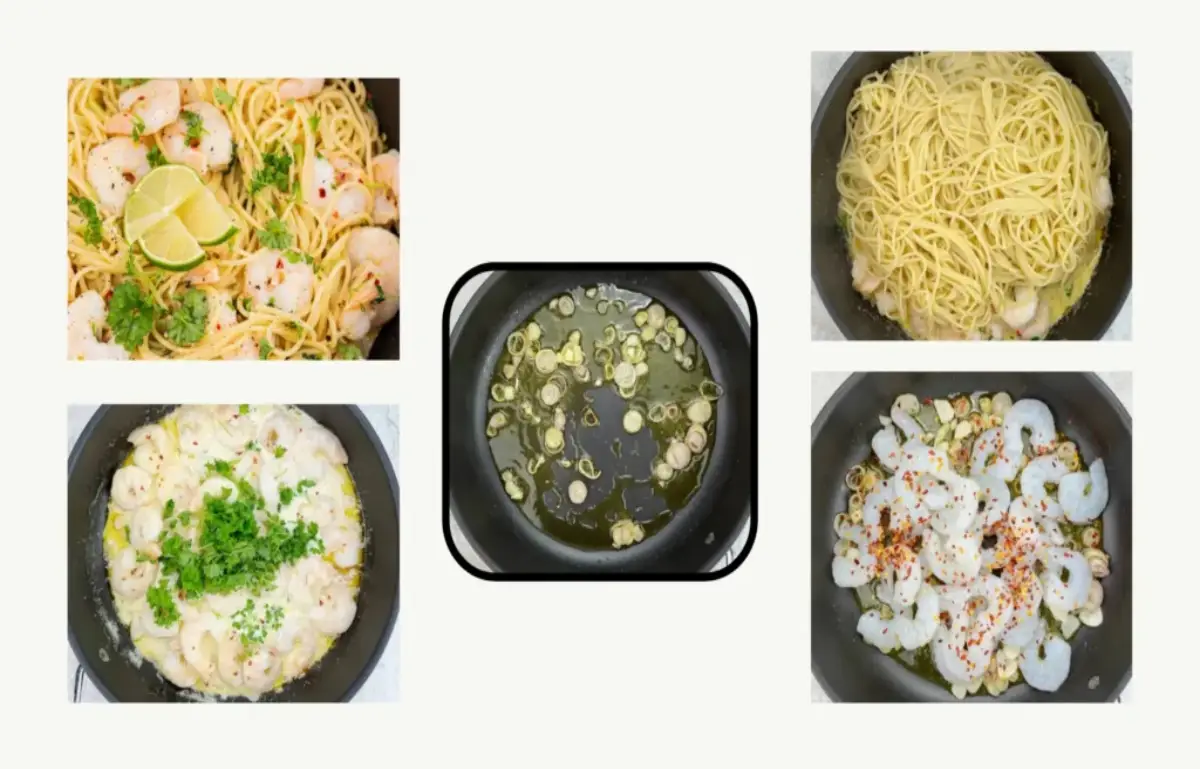Pasta with shrimp is a classic, delicious and easy to prepare recipe. The recipe can be used for many different things and more. Perfect for dinner on Valentine’s Day.
Pasta with shrimp Ingredients:
- 300 grams (weighed before cooking) spaghetti
- 500 g large, fresh or frozen shrimps
- Whipping cream (100 ml) 30% or 36%
- 40 grams of perfectly clarified butter; about 2 teaspoons
- Three tablespoons of good olive oil
- 40 g onion, preferably small shallots
- 2–3 cloves of garlic or 10–15 g
- two to three tablespoons of freshly squeezed lemon or lime juice
- a good pinch of dried chili flakes, a large bunch of parsley or coriander, half a teaspoon of salt and freshly ground pepper
Pasta with shrimps
Step 1: Prepare the shrimp
About 500 grams of giant shrimp (tiger or king) is required. First, remove the stems from any fresh, uncleaned shrimp you may have. Then remove the armor and possibly the tail. Finally, remove the black intestines of the shrimp by lightly tapping it on the back. After quickly rinsing the shrimp in cold water, pat them dry with paper towels. Frozen shrimp that have been blanched or cooked should already be thoroughly cleaned; no further action is required. All you need to do is let them thaw naturally, drain the glaze and pat dry with paper towels.
After thawing, you should check the frozen raw shrimp, note its frozen state on the container, and you can even move it, e.g. through the black intestines. To speed up the defrosting process, place the shrimp in a container with slightly warm water.
Step 2: Prepare the pasta.
You can start preparing the pasta as the shrimp in the sauce cooks quickly. It is best to fry it right after the shrimp in the sauce. After pouring the water from the colander, you can add it directly to the pot.
Fill a pot with water and heat until it boils. It takes three liters of water to boil 300 grams of dried pasta. Add salt to the water only when it starts to boil. Add a teaspoon of salt to boiling water. Cook the pasta al dente and put it in a pot.
You can stir the spaghetti once it is elastic enough to be completely submerged in the water. Once baked, it should be flexible enough to withstand a finger poke without breaking. I usually cook spaghetti one minute longer than the manufacturer recommends on the package. When the shrimps in the sauce are not ready, quickly transfer the cooked pasta to a strainer and put it back into the pot. From 300 grams of dry pasta you will get approximately 700 grams of cooked pasta.
Tip: It is a good idea to pour off some of the pasta cooking water. Then, to make more sauce, you can pour it into the pan with your meal. Another type of pasta you can prepare is linguine, penne or tagliatelle.
Step 3: Let the onion cook.
Start by heating a high-quality frying pan with a high edge and a thick bottom (mine is 28 cm). Add 40 g of clarified butter to a pan with three tablespoons of olive oil (you can add additional fat). Place about 40 grams or more of finely chopped onion (I used three small shallots) in the hot fat.
Tip: Remember that while the shrimp are cooking in the sauce, you can prepare the pasta of your choice.
Step 4: Add shrimp
Add two to three cloves of garlic, peeled and thinly sliced. Additionally, release the shrimp after 30 seconds. Increase the heat and add half a teaspoon of salt and a large pinch of chili flakes. Sprinkle two or three tablespoons of lime or lemon juice over the shrimp. Mix the ingredients in the pan.
One note: because shrimp cooks quickly, I only include the number of minutes it takes to fry raw shrimp, not the time to fry cooked shrimp. Over time it will be a bit similar. Gray shrimp will turn white and pink when raw.
Step 5: Add cream.
Lower the burner power to lower than usual. Pour 100 ml of 30% or 36% whipping cream into the pan, stirring gently with the shrimps all the time. Immediately add a large handful of finely chopped coriander or parsley. Combine all ingredients. Once the sauce reaches boiling point, wait ten to twenty seconds, then remove the pan from the heat.
You can add twice as much cream as a guide. A more velvety sauce will be yours. Additionally, this is a great technique for achieving a slightly more delicate flavor – for example, if you add too much chili or lemon juice.
Step 6: Add pasta.
Add freshly cooked pasta and spicy shrimp to the sauce in the pan.
Step 7: Add flavor and gift
Combine the pasta and sauce well. Add a bit of freshly ground pepper. Try spaghetti with shrimp and add spices if necessary. Immediately transfer food to plates. Add some parsley or coriander, half a slice of lemon or lime, fresh pepper or chili flakes and grated Parmesan cheese as a garnish.
Enjoy your meal!


